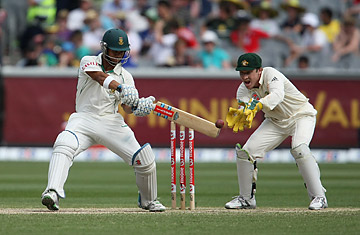
South African Jean Paul Duminy cuts past Australian wicket keeper Brad Haddin during the third day of the 3 mobile Series, Second Test, Australia vs. South Africa.
In Australia, it is being mourned as the passing of an era of global dominance: On Dec. 30, the South African national cricket team beat the Aussies in a five-day "test match" at the Melbourne Cricket Ground, taking an unassailable 2-0 lead in the three game contest, and handing Australia its first series defeat on home ground in 16 years. During that time, the Australian team had redefined the five-day version of the game — the only one that purists believe merits the devotion that they bestow on it — incorporating the sort of devil-may-care style of play that had hitherto been confined to the one-day game (in which each side has one, restricted innings, and therefore has to score more rapidly). The Australians made test cricket (which even its lovers will concede can be deadly dull) thrilling.
Australia's long run of success was certainly helped by a seemingly endless seam of talent; brilliant batsmen, fast bowlers, and a slow, spin bowler, Shane Warne, who managed to do things with a cricket ball that nobody else had even been able to imagine. But Warnie is retired from test cricket, his pudgy frame and perpetually highlighted hair now to be found in the TV commentary box (and a seemingly endless line of commercials) rather than on the field of play. In the first two tests of this southern summer, Australia's aging warhorses were comprehensively outplayed by a South African team that was hungrier and smarter. (See pictures of cricket matches.)
Cricket is on a roll. The economic center of the sport is now neither in Australia nor England, its place of birth, but in India, which this year hosted the first season of a loud, lurid and big-bucks premier league playing a short, fast and furious version of the game. It helps that the sport is wonderfully adapted to TV, as Kerry Packer, the legendary Australian media mogul understood a full 30 years ago, when he rocked the stuffy cricket establishment by signing up the best players from around the world and setting up his own televised world series. Because six deliveries are bowled from each end of the pitch in turn, the game lends itself to frequent commercial breaks. (See a video of India's passion for cricket)
In Australia, high tech — ultra slo-mo shots, infra-red cameras that enable you to see exactly what a ball has done, computer graphics way beyond anything attempted by the coverage of baseball on U.S. televsion — all enliven the viewing experience. And having always had a tradition of fine writing about the game (just like baseball) cricket now has its own literary masterpiece: Joseph O'Neill's highly regarded novel Netherland, set among the Caribbean and South Asian cricket playing immigrant community in New York — a book which demonstrates such a palpable love of the game that it must have won converts among those who picked it up thinking that it was just another story of life in New York after 9/11. (Which it also is, sort of.)
South Africa's on a roll, too, at least when it comes to sport. After winning the Rugby World Cup last year, its cricketers now stand atop the world rankings. And for once, that old adage the "rainbow nation" genuinely applies; South Africa's cricketers are white (both "English" and Afrikaans), black, colored and Indian — the discovery of the series in Australia was Jean-Paul Duminy, a brilliant and brave young colored batsman. In 2010, South Africa hosts the soccer World Cup. It won't win, but the success of its cricketers as they put the once-invisible Australians to the sword this month will have done nothing but lift South Africa's spirits as it prepares for the world's biggest sporting event.
